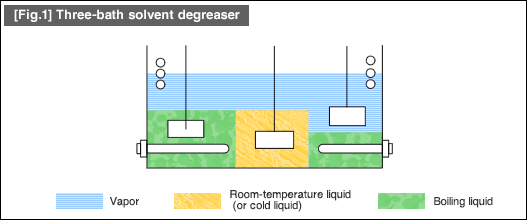(3) Cleaning with solvents
This is a solvent degreasing method that has been in use since the old times.In the past, trichloroethylene (TCE) and perchlorethylene (PCE) were used for this purpose. However, their use and production have been banned due to their toxicity.Currently, the following types of solvent are used for metal cleaning:
| (1) |
Aliphatic hydrocarbon --- Petroleum solvent |
| (2) |
Aromatic hydrocarbon --- Coal tar solvent |
| (3) |
Non-combustible solvent --- Chlorinated hydrocarbon |
| (4) |
Polar solvent --- Ketone, Alcohol, and Phenol |
These solvents are processed by a dedicated solvent degreaser and used in the following forms: vapor degreasing, liquid degreasing, and a combination of both as the most common method.(See [Fig.1]) First, clean a room-temperature workpiece in the vapor-phase tank filled with solvent vapor. As the temperature rises up to the steam temperature, cool it off with the room-temperature solvent. Then, heat up and dry the workpiece in the vapor-phase tank.

| (5) |
Special solution --- Emulsifying solvent, biphasic solvent, emulsion cleaner |
These types of solution are used in the liquid form (aqueous solution) for immersion degreasing.
(4) Cleaning by chemical reactions
This method includes acid pickling and alkaline rust removal.Fill a dedicated tank with solution. Soak the product in that tank to remove rust and activate the metal surface.There is also a method using an electrolytic action together.
| (1) |
Acids --- Make the oxides/sulfides soluble using hydrochloric acid and sulfuric acid, etc. |
| (2) |
Alkalis --- Alkaline salt and complex salt-forming agent (gluconic acid, thioglycolic acid salt, etc.) |
(5) Mechanical cleaning method
| (1) |
Wiping --- Use emery cloth or non-woven fabric (Scotch Brite™) and wipe it off with hand. |
| (2) |
Polishing and machining --- The most common method is buffing. Finish the surface as desired.([Fig.2]) |
| (3) |
Blasting --- Use abrasive materials such as silica sand, steel grit, or glass beads to create a satin finish. |
| (4) |
Blasting by water/air --- Use alumina or silicon carbide to make the surface smoother than (3). |



